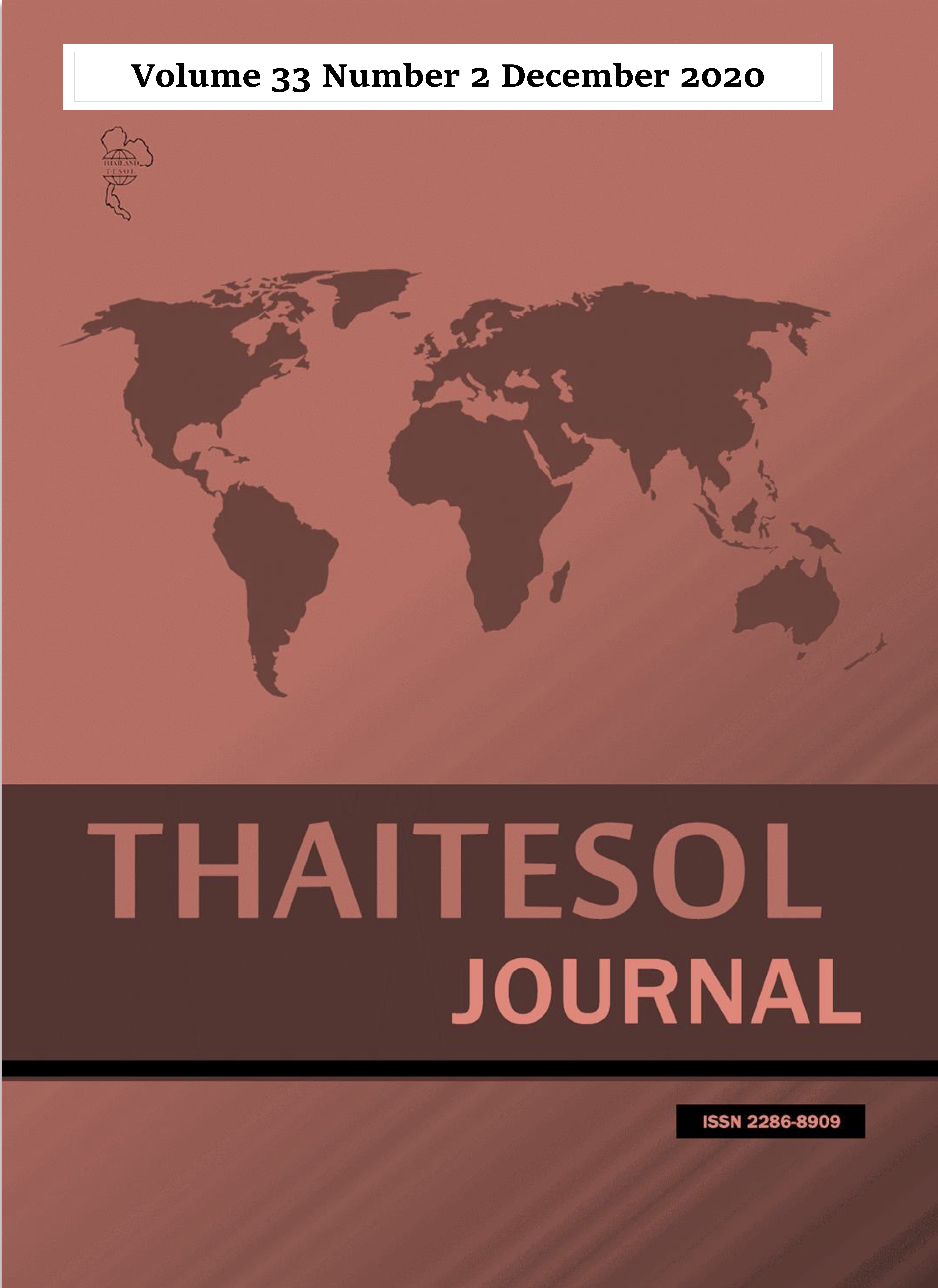Intercultural Communicative Language Learning Competencies of Undergraduate Students in an International Program in Thailand
Main Article Content
Abstract
The importance of understanding other cultures and intercultural communication is highlighted in today’s globalized world due to the proliferation of internationalization, increasing multinational cooperation, and mobility of world population. Therefore, intercultural communication is a required competence. In this study, intercultural communicative competence (ICC) is explored in the setting of language and culture classrooms. Then, ICC is expanded to intercultural communicative language learning competency (ICLLC). Since there are only a few international undergraduate programs in Thailand targeting ICC as the expected learning outcome, the recognition of ICLLC’s attributes and indicators benefits course developers and teachers realize how students develop ICLLC. This study aimed to identify ICLLC attributes and indicators, and to investigate ICLLC of undergraduate students in an international program. Firstly, a review of related literature toward intercultural communicative competence was done and followed by focus group interviews and educational connoisseurship method with 10 ELT experts to analyze and approve ICLLC attributes and indicators, teaching and learning activities, and assessment methods toward ICLLC. Twenty-four Thai undergraduates who were majoring in language and intercultural communication at an international college in Bangkok, Thailand were purposively selected using the three entrance examination recruitment criteria: English language proficiency, intercultural knowledge, and intercultural experience. Classroom observation, stimulated recall, journal writing, and semi-structured interview were utilized to portray students’ ICLLC. Analytic induction was used for data analysis. The results revealed that ICLLC consisted of four attributes and 21 specific indicators; 1) intercultural knowledge (with six indicators); 2) intercultural attitudes (with three indicators); 3) intercultural skills (with 10 indicators); and 4) critical cultural awareness (with two indicators). Students with higher levels of English proficiency and intercultural knowledge seemed to perform better ICLLC. Besides, willingness and motivation emerged as implementation forces to drive students to exhibit ICLLC. This study reveals deeper insights into development approaches to enriching ICLLC in international programs in Thailand.
Article Details
Materials in THAITESOL JOURNAL may be photocopied for educational purposes. Under no circumstances may any part of this journal be photocopied for commercial purposes.
References
Baldwin, J. R., Means Coleman, R. R., Gonzalez, Alberto, & Shenoy-Packer, S. (2014). Intercultural Communication for Everyday Life. UK: Wiley Blackwell.
Burns, A. & Richards, J.C. (2009). The Cambridge Guide to Second Language Teacher Education. New York: CUP.
Byram, M. (1997). Teaching and Assessing Intercultural Communicative Competence. Clevedon, UK: Multilingual Matters.
Chen, G. M., & Starosta, W. J. (1999). A review of the concept of intercultural awareness. Human Communication, 2, 27-54.
Creswell, J.W. (2013). Research Design: Qualitative, Quantitative, and Mixed Methods. Thousand Oaks, CA: Sage
Deardorff, D. K. (2006). Identification and assessment of intercultural competence as a student outcome of internationalization. Journal of Studies in International Education, 10(3), 241-266. Retrieved from http://dx.doi.org/10.2307/1176856
Diaz Frias, V.M. (2014). Working with competences in the ESL/EFL classroom. MEXTESOL Journal, 38(2), 1-15.
Duyen, H. T. P., (2019). Vietnamese teachers’ perceptions of integrating intercultural communicative competence (ICC) into business English teaching. THAITESOL Journal, 32(2), 17-30.
Gordon, R., & Mwavita, M. (2018). Evaluating the international dimension in an undergraduate curriculum by assessing students’ intercultural sensitivity. Studies in Educational Evaluation, 59, 76-83.
Hismanoglu, M. (2011). An investigation of ELT students’ intercultural communicative competence in relation to linguistic proficiency, overseas experience and formal instruction. International Journal of Intercultural Relations, 35, 805-817.
Hyland, K., & Wong, L. C. (2013). Innovation and Change in English Language Education. New York: Routledge.
Jenkins, J., Baker, W., & Dewey, M. (2018). The Routledge Handbook of English as a Lingua Franca. New York: Routledge.
Kim, J. S. (2019). Multicultural Literacy for English Language Learners. Republic of Korea: Han Kook Publishing Company
Lavankura, P. (2013). Internationalizing higher education in Thailand: Government and university responses. Journal of Studies in International Education, 17(5), 663-676.
Marlina, R. (2018). Teaching English as an International Language Implementing, Reviewing, and Re-envisioning World Englishes in Language Education. New York: Routledge.
Maude, B. (2016). Managing Cross-Cultural Communication: Principles & Practice. (2nd ed.). UK: Macmillan Education.
Mitchell, R., & Myles, F. (2004). Second Language Learning Theories (2nd ed.). London: Arnold.
Neuliep, J. W. (2015). Intercultural Communication: A Contextual Approach. Thousand Oaks, CA: Sage
Newton, J. (2016). Cultivating intercultural competence in tertiary level EFL programs. Crossing Borders in Language Teaching and Business Communication: Proceedings of the 11th ELT conference at AE CYUT, 1-22. Retrieved fromhttps://www.researchgate.net/publication/312372899_Cultivating_intercultural_competence_in_tertiary_EFL_programs/link/587c061a08ae4445c06435eb/download
Nomnian, S. (2018). Synergizing transcultural Learning of Global Englishes: Voices of Chinese Exchange Students in a Thai University. Bangkok: ELT Education (Thailand).
Quyen, V. P. (2018). Students’ perceptions to cultivating intercultural competence activities: A case study of a Vietnamese university. THAITESOL Journal, 31(1), 33-48.
Reimers, F. M., & Chung, C. K. (2016). Teaching and Learning for the Twenty-First Century: Educational Goals, Policies, and Curricula from eight Nations. Cambridge: Harvard Education Press.
Sorrells, K. (2013). Intercultural Communication: Globalization and Social Justice. CA: SAGE.
Tamam, E. (2016). Are University Students Getting Enough Interethnic Communication and Diversity Engagement Experiences? Concerns and Considerations. Serdang, Malaysia: Universiti Putra Malaysia Press.
Taylor, R. (2013). Intercultural Communication: A Survival Guide for Non-native English Speakers. Bangkok: Thammasat University Press.
Tran, T. Q., & Seepho, S. (2016). EFL learners’ attitudes toward intercultural communicative language teaching and their intercultural communicative competence development. Journal of English Studies, 11, 1-40.
Wiseman, R. L. (2002). Intercultural Communication Competence. In W. B. Gudykunst & B. Mody (Eds.), Handbook of International and Intercultural Communication (2nd ed.) (pp. 207-224). Thousand Oaks, CA: Sage.
Zhou, C., & Griffiths, C. (2011). Intercultural communicative competence. English Language and Literature Studies, 1(2), 113-122.


